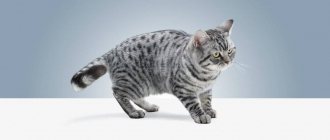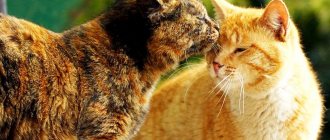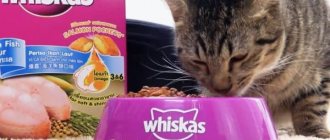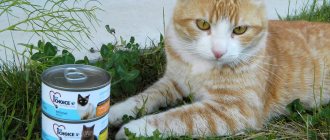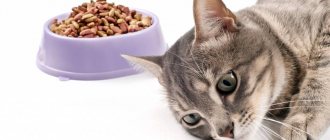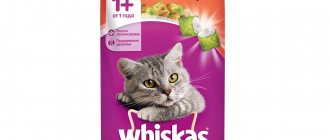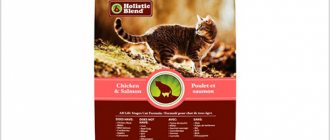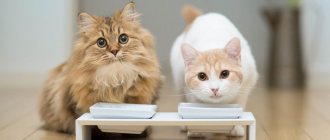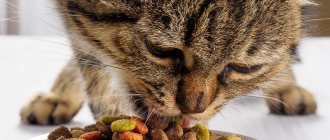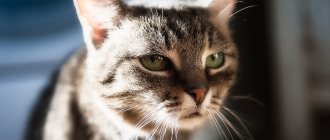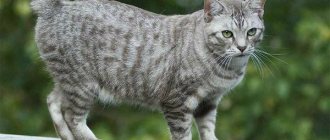The packaging of cat food always indicates its composition, the list of components of which is arranged in descending order of their mass fraction. According to State Standards, regulated indicators include fats, proteins, soluble and insoluble carbohydrates (these are so-called dietary fiber), and water. The percentage of mineral additives or ash content must also be indicated.
The last ingredient often seems strange to cat owners. Why include ashes in the food, because when feeding an animal with natural products prepared at home, no one does this. But the “ash” indicated on the packaging is not ash, but the amount of non-combustible residue that would be formed by burning 100 g of feed at a temperature of 500 ° C. This is an important indicator that you need to focus on when choosing food.
Where does ash come from?
Of course, no one deliberately adds ash to dry food. This word refers to all the minerals contained in the feed product. The roots of such a strange name lie in the method of determining the level of content of these substances: a portion of the feed is burned in a special oven, and then the dry residue, which is externally ash and ash, is evaluated.
From a chemical point of view, these are magnesium, calcium, phosphorus and other minerals. They go into feed together with raw materials: meat, fish, poultry and other products.
Cereal flour
The farther, the sadder.
And we ask the questions again: Which grain crops? Why flour? Why grain crops? And there are no answers. Because this ingredient is one of the most undesirable in dog and cat food. Roughly speaking, “grain flour” is a waste from flour milling, and grains, in principle, are not needed by predators, especially cats? In addition, the composition of this waste is not precisely known. ⠀ Any cereal flour contains a lot of carbohydrates and some share of vegetable proteins. Some of them, such as gluten, are difficult for carnivores to digest and cause food intolerance and, consequently, various diseases. Therefore, the nutritional value of the ingredient is 1 point out of 10. It’s scary what awaits us ahead. ⠀
Is ash harmful to cats?
Increased interest in this indicator arose when the mechanism of stone formation in the urinary tract of cats became clear. It turned out that the crystals that settle in the urine consist of certain minerals. From this it was hastily concluded that the presence of these substances in feed is undesirable and should be reduced as much as possible.
Meat products are the leaders in terms of mineral content. But plant foods contain significantly less of these substances (this is explained by the peculiarities of plant metabolism). Therefore, the discovery of the mechanism of formation of urinary stones has become an indulgence for manufacturers wishing to produce feed from cereals and other plant components. However, a grain diet did not rid cats of ICD, because in practice everything turned out to be more complicated.
Which raw material contains more ash?
Ash is contained in all products, but as for meat, there is much less ash in muscle tissue than in bones. Carefully read the composition of food with high ash, preferably in English, and you will see that mainly whole carcasses (with bones) will be used as meat ingredients in such food, rather than fillets. But feed with a high content of cereals will have a very low ash content. So the more meat (even with bones), the better the food, and the inevitably higher the ash.
Calcium and phosphorus - under control
Subsequently, it was discovered that not all minerals are responsible for the formation of stones. The main materials for this “construction” turned out to be calcium and phosphorus, and not separately, but together and in a certain proportion. Unlike ash, the calcium and phosphorus content is required to be indicated on packages of finished feed. It is these values, and not the ash content, that you should rely on when choosing a diet.
The recommended calcium to phosphorus ratio is 1.2:1. But options ranging from 1.17:1 to 1.4:1 are acceptable. These figures were obtained by analyzing the content of these minerals in the carcasses of rodents, which are the typical food of cats in their natural habitat.
Information about the calcium-phosphorus ratio is not always indicated. But nothing prevents you from calculating this parameter yourself: you just need to divide the calcium indicator by the phosphorus indicator. Ideally, the resulting number will be close to 1.2.
But even this will not provide complete protection against urolithiasis if another risk factor is not taken into account, which is associated not only with ash content - the acidity of urine.
What is ash content
Sometimes cat owners wonder why ash is needed in food. When a little purr eats natural food, no one feeds it with ash. The fact is that the indication “ash” on the packaging is the amount of non-combustible residue formed when 100 g of feed is burned at a temperature of 500 °C. You should pay attention to this indicator when choosing diets for your cat.
The feed contains organic (fats, proteins and carbohydrates) and inorganic (minerals) substances. Organic substances burn completely, and when inorganic components are burned, a non-combustible residue remains. The percentage is called ash content. In other words, this is an indicator of the content of minerals in the diet.
Acidic versus alkaline
Normally, all carnivores, including cats, have slightly acidic urine (pH up to 6.5). This is what becomes a kind of “immunity” from the formation of stones. Indeed, in an acidic environment, crystals, which then turn into stones, are not able to form, and as a result, their potential components leave the body along with urine.
If the urine becomes alkaline and the pH reaches 7, then the risk of crystal formation increases sharply. And here the high content of minerals in food can play a negative role.
What causes alkalinization of urine? Magnesium is often blamed for this - it is always contained in ash in dry food. It can really affect the pH and tip the scales towards the alkaline side.
Fish fat
Typically, fish oil is obtained from marine fatty cold-water fish such as menhaden, anchovies, herring and mackerel. And some manufacturers directly indicate the source of the ingredient - for example, “cod liver oil” (nutritional value according to the checkpoint service - 6️⃣ points out of ?) or “fresh salmon oil” (7️⃣ points out of ?). ⠀ The wording “fish oil” only indicates that a mixture of fats from different types of fish was probably added to the food. And this is a controversial point: it is unclear what products and preservatives were used in its production. The quality of fish oil and the degree of its purification directly affect its cost and, consequently, the cost of feed. ⠀ ❤️ However, regardless of the type of fish and production technology, fish oil is a source of energy and Omega-3 fatty acids, including DHA (docosahexaenoic acid) and EPA (eicosapentaenoic acid). That’s why we give it to our animals and, if desired, take it ourselves!
Optimal Magnesium Levels
It is impossible to significantly reduce the level of magnesium in an animal’s diet, since it is an important trace element involved in more than 300 metabolic processes in the body. Scientists and industry specialists had to take this issue seriously and conduct a series of experiments.
As a result, it was possible to reveal that the optimal level of magnesium in dry food is approximately 1000 mg/kg (0.1%). However, do not be afraid of a higher value, because the need for magnesium depends on parameters such as age and other characteristics of the animal’s body. In some diets this figure may be significantly higher, and this is normal. The maximum limit, after which the risk of urolithiasis increases sharply, is 3500 mg/kg (0.35%). However, you will not find such values in any ready-made diet.
Fructooligosaccharides
Interesting, ironic and a little sad? ⠀ Here we are at the last of the 14 premium cat food ingredients. And the last place in the list of ingredients means the smallest share in the product. Ironically, this ingredient has the maximum nutritional value - 6️⃣ points out of ?. We have never seen such high indicators in this premium food ❗️Well... ⠀ Fructooligosaccharides are a type of healthy prebiotics, fermentable fibers that are not digested in the intestines, but are quickly fermented by the microflora of the colon. They: improve the growth and reproduction of beneficial microflora, improve digestion and strengthen the immunity of animals. ⠀ Due to what? Fructooligosaccharides release volatile fatty acids, an ideal environment for the maintenance and renewal of epithelial cells of the colon wall. Thus, they help the pet’s body maintain balance in the intestines. ⠀ And yet let’s grumble a little. If the manufacturer does not indicate the exact amount of this ingredient, we have no reason to expect that the supplement will actually affect the health of the animal. Therefore... let's look together for those packages that contain all the necessary information.
For the predator - meat
Another significant risk factor for ICD in cats is a diet that is not typical for carnivores. Grains and other carbohydrate ingredients increase urine pH (tend it toward the alkaline side). But meat components, on the contrary, help maintain an acidic environment. This is caused by the breakdown of excess amino acids that enter the urine during the digestion of high-protein foods. Studies have confirmed that stones do not form in an acidic environment, even with a diet rich in minerals.
Therefore, dry food with a high ash content (due to meat components) will always be better than grain food. Some manufacturers find a way out by “acidifying” their products with the help of synthetic additives, but this method is considered not entirely safe. It is much simpler and more natural when a cat eats as “programmed” by nature: meat and entrails of animals.
This will not only reduce the risk of stone formation, but will also protect your pet from a number of other diseases. It is also very important to provide him with round-the-clock access to fresh drinking water: it will help remove excess minerals from the body.
Mechanism of development of urolithiasis
As you can see, ash itself has no effect on the occurrence of urolithiasis. However, its individual components do not cause symptoms of ICD, even in excess. The fact is that the causes of ICD are interrelated:
It all starts with changing the pH of the urine - towards acidification or alkalization. Fluctuations in pH throughout the day can occur in perfectly healthy cats, so the altered environment must remain that way long enough for crystals to form. In excessively acidic urine, other crystals form - calcium oxalates, which are no better than struvite, and maybe even worse - it is impossible to dissolve calcium oxalates, only surgical removal. By the way, acidifying foods with the prevention of urolithiasis, so beloved by cat owners, as we can conclude, are not at all useful on an ongoing basis.
Also, in order for crystals to grow in the urine and form into larger stones, a certain stagnation of urine is needed - a decrease in the frequency of diuresis. In other words, the less often your cat urinates, the worse it is for him and the better for the stalactites and stalagmites in his bladder.
Thus, we conclude that the ash content of the feed has absolutely no effect on the development of urolithiasis. You should pay attention to the content of individual minerals, and not to the ash indicator.
conclusions
- Without minerals, no living organism can survive: they are participants in many biochemical life-support processes. Therefore, the demonization of ash in dry food is completely unjustified.
- The total percentage of ash content is not important. First of all, you need to monitor the ratio of calcium and phosphorus, as well as the level of magnesium. These indicators are always indicated in the guaranteed analysis.
- An effective prevention of urolithiasis will not be to reduce the level of ash in dry food, but to increase the meat content in it, as well as the correct drinking regime.
Where are the most minerals?
Meat, fish and other meat components contain quite a lot of minerals, but there are still less of them in muscle tissue than, for example, in bones. If meat with bones or meat-and-bone meal is used to produce feed, the ash content of the product will be higher than when using “naked” pulp.
Grains and other plant components are even lower in mineral content, so feeds that consist primarily of grains or other plants will have less ash.
Until the 1980s, ash content in cat food, or more precisely its level, was strongly associated with the risk of developing urolithiasis, but a number of large-scale studies of both the disease itself and the influence of nutrition on its development, in particular feeding cats with dry diets, have convincingly proven that this connection is not so obvious and even erroneous.
Let's walk together along the path trodden by scientists and see what reasons they give to prove their conclusions.
Prevention of ICD
Therefore, artificial acidification of feed is not a suitable method. To achieve the desired effect in the safest way, it is enough to add more meat components to the diet, and the urine pH will acquire a normal level of acidity for a cat, which will serve as an excellent prevention of urolithiasis.
Here, however, it would not be amiss to mention that we are talking only about prevention. When the disease has already begun, the animal needs a special diet, which, depending on the type of disease - struvite or oxalate, will promote either oxidation or alkalinization of urine, as well as support the urinary system with the help of special supplements. And the ash content in cat food has nothing to do with this!
More water
In conclusion, we note that not only poor diet (low in animal protein and high in grains) is a risk factor for urolithiasis. A very important point is that the cat consumes enough water, which is especially important if the animal eats only dry food.
The history of the evolution of the cat as a biological species takes us to hot semi-deserts, where the cat literally cried out for water. In this regard, the animals’ bodies have learned to save water, releasing it in small quantities to produce urine. Therefore, urine in cats is very concentrated, which certainly contributes to the formation of deposits in the form of sand and stones in the urinary system.
Of course, neither desert cats nor their wild counterparts in other climatic zones usually suffer from any ICD, since they feed exclusively on meat and thus maintain a normal pH level. In addition, even if there is no stream nearby, after each successful hunt they get quite a lot of liquid, eating the whole prey fresh.
More movement
Finally, they move a lot! And this is also a very important factor in the prevention of urolithiasis, since movement promotes proper metabolism, which does not cause excessive accumulation of minerals in the body.
So, if you want your cat to never be diagnosed with urolithiasis, feed her as close as possible to the diet she evolved to eat, which is a diet high in animal protein.
Don't believe the tales that our domestic cats have gone far from their ancestors - they simply did not have time for this. For evolutionary changes that will lead from carnivory to “grain-eating”, and this is precisely the diet offered to them by many producers, millions of years are needed, and cats were roughly domesticated about 10 thousand years ago.
Norms of ash content in feed
Typically, dry pet foods have higher ash contents than wet pet foods. According to veterinary standards, the optimal amount of ash in cat food is 6-7%.
Attention! A percentage of ash that exceeds the norm indirectly indicates the presence of low-quality waste (for example, meat and bone meal) in the feed. The use of such food can negatively affect the cat’s health. An ash content below the norm indicates that the food does not contain the required amount of microelements.
